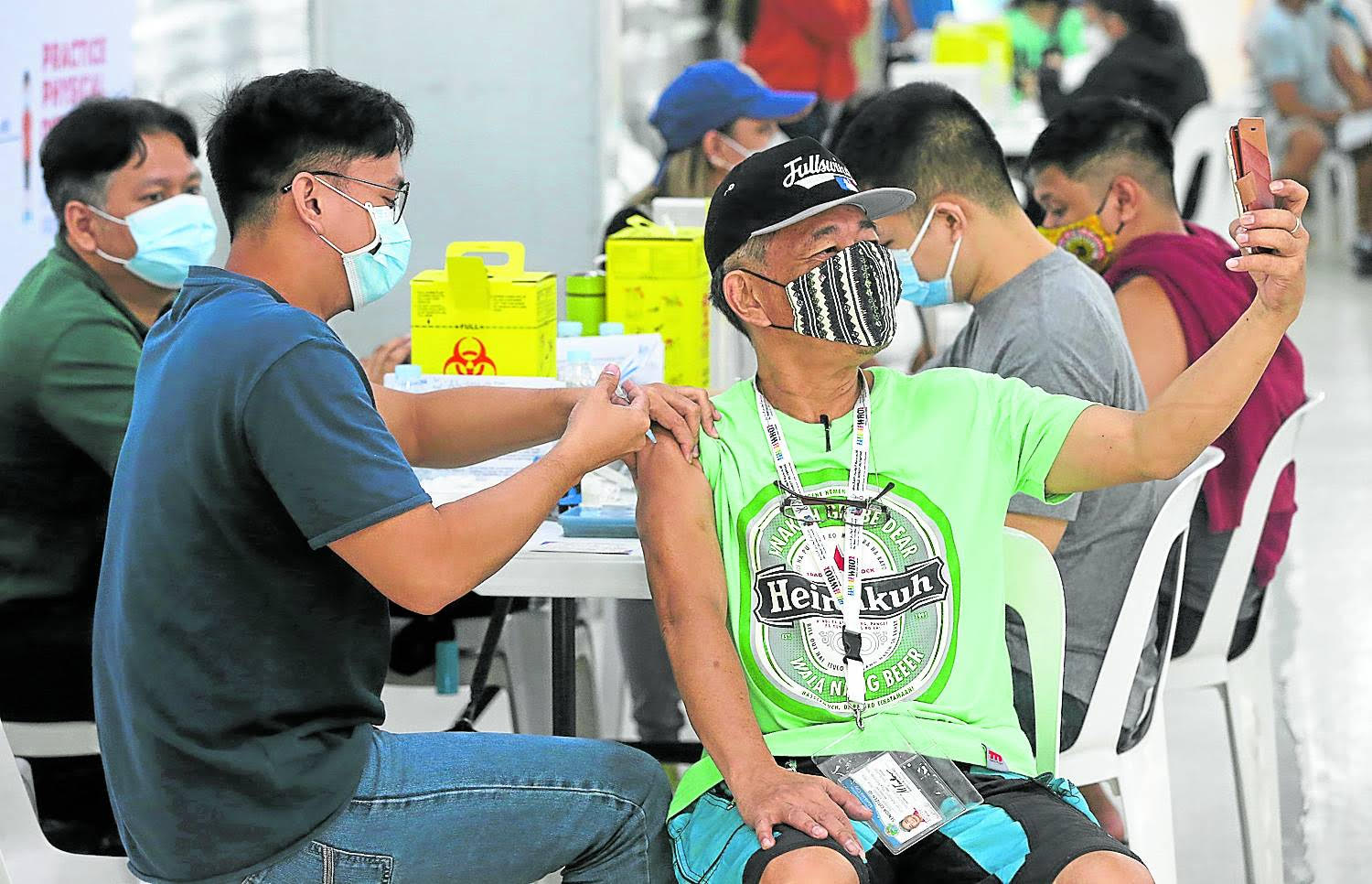Gov’t can replace companies’ expired jabs, but ‘not for free’

A Marikina resident takes a selfie while getting a booster shot. NIÑO JESUS ORBETA/FILE PHOTO
The Department of Health (DOH) parried criticism over the expiration of millions of vaccines bought by the private sector, which a business leader had blamed on its supposed “lack of urgency” and late decision to let more segments of the population get a second booster shot.
Health Undersecretary and DOH spokesperson Beverly Ho explained, however, that the government is open to replacing the expired doses—at a cost to the companies.
In a media briefing on Thursday, Ho maintained that the DOH vaccination drive remained “safe and science-based.”
“We want to assure the public that there’s a process for making sure that the entire program uses vaccines that are safe. We abide by evidence when we expand indications or use of our vaccines,” Ho said in a media forum when sought for comment about the wasted doses.
“So with that principle, it got us to where we are now, which is 71 million Filipinos vaccinated [and we were] able to open the economy and [the country]… because of this cooperation that we’ve had with each of the [vaccine] experts as well as the private sector supporting the government in the rollout,” she added.
Concepcion complaint
On Wednesday, the DOH expanded the coverage of second booster shots to include those in the 50 to 59 age bracket and adults with existing comorbidities.
But this development still did not sit well with former presidential adviser on entrepreneurship and Go Negosyo founder Joey Concepcion, who said the “lack of urgency” on the part of the DOH and the Health Technology Assessment Council (HTAC), an independent advisory body for medical interventions and technologies, cost the private sector 4.25 million doses worth some P5 billion.
Since May, representatives of business groups had urged the government to include economic front-liners to the sectors eligible for second boosters, citing high acceptance rate among them.
In recognizing the losses, the government is open to giving some stocks from the national stockpile to the private sector, but at a cost.
“They (the companies) have raised that their employees are more interested now to get vaccinated. And so the national stockpile is available. We can give it to them [and] they can manage the administration, but we can’t give them the vaccines for free,” Ho said.
She also noted that the government was also in talks with the World Health Organization-initiated COVAX facility to replace the expired vaccines from the national stockpile and whether it could do the same for the private sector.
As of July 27, more than 71.6 million had been fully vaccinated, some six million short of the government target of 78.1 million. At least 16 million had availed themselves of first booster shots, while 1.2 million already received their second boosters.
Increased risk in NCR
While Metro Manila is back to moderate risk for COVID-19 transmission, the overall risk nationwide remains low, the DOH reported also on Thursday.
Based on the latest DOH data, the seven-day moving average of infections in the capital region was at 1,100 a day, up from an average 900 daily cases in the previous week. The rest of the island groups, however, showed “continued slow increases.”
Metro Manila’s average daily attack rate (Adar), or the number of individuals infected per 100,000 population, was also at moderate risk at 7.25. The rest of the regions remained at low risk based on their respective Adar.
“Nationally, we are still at low risk case classification with an [Adar] of 2.43 cases per 100,000, with all regions showing case increases in the recent one and two weeks,” DOH said.
Severe and critical admissions also remained at low risk, with less than 1,000 cases since March. Overall usage of the health-care system in the capital region was also low at 35.5 percent, DOH noted.
There were 890 new cases of the highly transmissible Omicron subvariant BA.5 detected in the latest genome sequencing run from July 22 to 26, bringing the total number of such cases in the country to 1,997.
Of the new BA.5 infections, most were from Western Visayas and Metro Manila, with 252 and 232 cases, respectively. Majority of the infected individuals were fully vaccinated and 823 had been tagged as recovered.
The Philippine Genome Center also detected 18 additional BA.4 cases and 15 more cases of BA.2.12.1 during the same period.
For more news about the novel coronavirus click here.
What you need to know about Coronavirus.
For more information on COVID-19, call the DOH Hotline: (02) 86517800 local 1149/1150.
The Inquirer Foundation supports our healthcare frontliners and is still accepting cash donations to be deposited at Banco de Oro (BDO) current account #007960018860 or donate through PayMaya using this link.